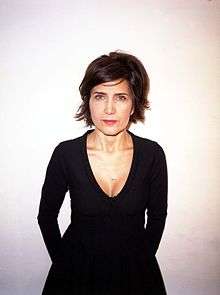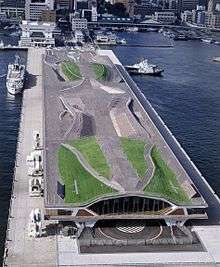Farshid Moussavi
Farshid Moussavi OBE RA (born in 1965, Shiraz, Iran) is an Iranian-born British architect, educator, and author. She is the founder of Farshid Moussavi Architecture (FMA) and a Professor in Practice of Architecture at Harvard University Graduate School of Design.[1] Before forming FMA, she was co-founder of the London-based Foreign Office Architects or FOA (1993-2011), recognised as one of the world's most creative design firms, integrating architecture, urban design, and landscape architecture in a wide range of projects internationally.[2] Moussavi was elected a Royal Academician in 2015, and subsequently, Professor of Architecture at the RA Schools in 2017.[3] She was appointed Officer of the Order of the British Empire (OBE) in the 2018 Queen's Birthday Honours for Services to Architecture.
Farshid Moussavi | |
|---|---|
 | |
| Born | 1965 (age 54–55) Shiraz, Iran |
| Nationality | British |
| Alma mater | Harvard University Bartlett School of Architecture, University College London Dundee University |
| Occupation | Architect |
| Practice | Farshid Moussavi Architecture Previously Foreign Office Architects |
| Buildings | Ōsanbashi, International Passenger Terminal, Yokohama, Kanagawa, Japan Museum of Contemporary Art, Cleveland, Ohio |
| Website | Official website |



Early life and education
Moussavi was born in 1965 in Shiraz, Iran and immigrated to London in 1979 to attend boarding school.[4][5] She trained in architecture at the Dundee School of Architecture, University of Dundee, The Bartlett School of Architecture, University College London and graduated with a Masters in Architecture (MArch II) from the Harvard University Graduate School of Design (GSD). While at the Harvard, Moussavi met architect Alejandro Zaera-Polo.[6]
Career
Moussavi first came to prominence with Foreign Office Architects (FOA), the practice she co-founded in 1993 with her ex-husband Alejandro Zaera-Polo.[7] At FOA, Moussavi co-authored the design for the award-winning Yokohama International Ferry Terminal in Japan (which was subject to an international design competition in 1995) and was part of the United Architects team who were finalists in the Ground Zero competition. She also completed a wide range of international projects including the John Lewis complex in Leicester, England and the Meydan retail complex in Istanbul, Turkey.
In June 2011 after splitting with Zaera-Polo, Moussavi re-established her own London-based practice, Farshid Moussavi Architecture (FMA).[7] Her notable projects with FMA include the Museum of Contemporary Art Cleveland, Victoria Beckham's Flagship Store in London, a residential complex in the La Défense-Nanterre district of Paris, a multi-story residential building in Montpellier, and the Harrods Toys Department in London. The practice is currently working on a number of high-profile projects including an office tower for the City of London. It was a finalist for London National Portrait Gallery competition, and joint winner of the international competition for the new headquarters of the International Olympic Committee (IOC) in Lausanne.
Research
Alongside her professional practice, Moussavi has held a longstanding commitment to research across the academic and professional field of architecture. Since 2005, she has been Professor in Practice at Harvard University Graduate School of Design.[3] Previously, Moussavi taught at the Architectural Association in London for eight years (1993–2000), and was subsequently appointed as Head of the Academy of Fine Arts in Vienna (2002–2005). She has been a visiting professor of architecture at the Berlage Institute in Rotterdam, the Hoger Architectuur Instituut Sint-Lucas in Gent, and in the US, at UCLA, Columbia University and Princeton University.
Moussavi's research, which began while teaching at the Architectural Association in the early 90s, has focused on instruments that allow architects to embed built forms with design intelligence and creative possibilities – such as the diagram, information technology, new construction technologies, envelopes and tessellation – and how they can be used to develop alternative concepts for the practice of architecture.
Since 2004, Moussavi's research has focused predominantly on the relationship between the construction and experience of a built form, and how the architect's agency is to navigate the many choices provided by the design process to give built forms the unique propensities which individuals experience as affect. Her work in aesthetics is influenced by a range of philosophers, notably Spinoza, Gilles Deleuze and Félix Guattari, and Jacques Rancière. Following from Gilles Deleuze's work on affect, she proposes that built forms' affects play an active role in the daily experiences of individuals and the affections they develop. Moussavi argues that, in order to move people's experience away from routine and to open up the possibility for new types of action, architects need to provide built forms with novel affects. It is not what built forms represent but how they provide experiences that would otherwise not exist that makes their aesthetic experience relevant and gives their architecture a function or agency in culture.
Moussavi has published three books: The Function of Ornament, The Function of Form and The Function of Style in conjunction with her teaching at Harvard, all of which disclaim architecture's traditional binary oppositions – form vs.function, structure vs. form, ornament vs. function, style vs. function – proposing that architecture's creative potential lies, rather, in finding ways to relate them to one other.
Select projects
Farshid Moussavi Architecture
- 2018 – Harrods Toys Department, London, England[8]
- 2014 – Victoria Beckham Flagship Store, London, England[9]
- 2013 – Les Jardins de la Lironde Residential Complex, Montpellier, France[10]
- 2012 – Museum of Contemporary Art, Cleveland, Ohio[11][12][13]
- 2012 – Installation for Common Ground at 13th Architecture Biennale in Venice[14]
Awards
This is a select list of Moussavi and Foreign Office Architects (FOA) awards.
| Year | Award name | To | By | For | Notes |
|---|---|---|---|---|---|
| 2004 | Enric Miralles Prize for Architecture | Foreign Office Architects | Yokohama International Passenger Terminal | [17] | |
| 2004 | Lion Award for Topography | Foreign Office Architects | 9th Venice Architecture Biennale | [18] | |
| 2011 | RIBA Award in the education and community category | Foreign Office Architects | Royal Institute of British Architects (RIBA) | Ravensbourne campus | [19] |
| 2018 | Order of the British Empire (OBE) award | Farshid Moussavi | Order of the British Empire | awarded for service and diversity in the architecture profession | [20] |
Publications
 The Function of Ornament (2006)
The Function of Ornament (2006) The Function of Form (2009)
The Function of Form (2009) The Function of Style (2014)
The Function of Style (2014)
Books
- Moussavi, Farshid; Kubo, Michael (2006). The Function of Ornament. Harvard Graduate School of Design, ACTAR. ISBN 978-8496540507.
- Moussavi, Farshid; Lopez, Daniel; Schricker, Ahmadreza; Ambrose, Garrick (2009). The Function of Form. Harvard Graduate School of Design, ACTAR. ISBN 978-8496954731.
- Moussavi, Farshid (2014). The Function of Style. ACTAR. ISBN 978-1940291307.
Articles
- Moussavi, Farshid (21 September 2011). "Viewpoints: Farshid Moussavi on the need for parametric thinking". The Architectural Review.
- Moussavi, Farshid (24 December 2011). "Viewpoints: Farshid Moussavi on Activism". The Architectural Review.
- Moussavi, Farshid (28 May 2012). "Farshid Moussavi on Women in Architecture". The Architectural Review.
- Moussavi, Farshid (28 September 2012). "School buildings produce culture". The Architectural Review.
- Moussavi, Farshid (31 January 2013). "Viewpoints: Farshid Moussavi on Competitions". The Architectural Review.
- Moussavi, Farshid (19 December 2013). "Farshid Moussavi: Planning is an art form". The Architectural Review.
- Moussavi, Farshid (4 June 2014). "Style and Substance: Interview with Farshid Moussavi". The Architectural Review.
References
- "Interview: Farshid Moussavi, Architect, Author and Professor". Something Curated. 7 July 2016. Retrieved 19 December 2018.
- "Farshid Moussavi - Harvard Graduate School of Design". www.gsd.harvard.edu. Retrieved 17 December 2019.
- "Farshid Moussavi, Artist". Royal Academy of Arts. 2015. Retrieved 19 December 2018.
- Kenrick, Vivienne (28 September 2002). "Farshid Moussavi". The Japan Times Online. ISSN 0447-5763. Retrieved 19 December 2018.
- Adams, Author: Henry (16 December 2012). "MOCA and the Dome of Heaven". Collective Arts Network - CAN Journal. Retrieved 19 December 2019.
- Chamberlain, Lisa (2008). Slackonomics: Generation X in the Age of Creative Destruction. Da Capo Press. p. 159. ISBN 978-0786718849.
- Moore, Rowan (16 November 2014). "Farshid Moussavi: 'We are in a world where ideas migrate'". The Guardian. ISSN 0261-3077. Retrieved 19 December 2018.
- "Farshid Moussavi's new Harrods Toy Department is a joyful exercise in colour theory". Wallpaper* Magazine. 18 June 2018. Retrieved 19 December 2018.
- Compton, Nick (22 September 2016). "The 'unpredictable' architect behind Victoria Beckham's flagship store". Wired UK. ISSN 1357-0978. Retrieved 19 December 2018.
- Garcia Menocal, Cat (17 April 2013). "farshid moussavi architecture wins montpellier tower residence competition". designboom. Retrieved 19 December 2018.
- "Museum of Contemporary Art Cleveland, designed by Farshid Moussavi". Wallpaper* Magazine. 22 October 2012. Retrieved 19 December 2018.
- Rawsthorn, Alice. "Build It and They Will Come". W Magazine. Retrieved 19 December 2018.
- Ryan, Raymund. "Blue Steel: MOCA by Farshid Moussavi in Cleveland, Ohio". Architectural Review. Retrieved 19 December 2018.
- Rawsthorn, Alice (2 December 2012). "Defining the Emotional Cause of 'Affect'". The New York Times. ISSN 0362-4331. Retrieved 19 December 2018.
- "ShowCase: John Lewis Department Store and Cineplex". Archinect. Retrieved 19 December 2018.
- Woodman, Ellis (2 May 2008). "Foreign Office Architects: No, it's not a Guggenheim - it's a John Lewis". Daily Telegraph. ISSN 0307-1235. Retrieved 19 December 2019.
- "AD Classics: Yokohama International Passenger Terminal / Foreign Office Architects (FOA)". ArchDaily. 17 October 2018. Retrieved 19 December 2018.
- "11th Annual Arthur Rosenblatt Memorial Lecture: Farshid Moussavi: Thoughts on New Architecture". Archpaper.com. Retrieved 19 December 2018.
- "Ravensbourne by Foreign Office Architects". Archinect. Retrieved 19 December 2018.
- "Farshid Moussavi recognized with Order of the British Empire award amid Queen's Birthday Honours 2018". Harvard Graduate School of Design. Retrieved 19 December 2018.
External links
| Wikimedia Commons has media related to Farshid Moussavi. |
- Official website
- FunctionLab website, the research arm of Farshid Moussavi Architecture.
- Farshid Moussavi profile at Harvard University, Graduate School of Design
- Farshid Moussavi profile, Royal Academician
- Profile on Royal Academy of Arts Collections
- Royal Academy Schools
- Norman Foster Foundation
Video links
- Farshid Moussavi in conversation with Nader Tehrani lecture video at Harvard University, 2012
- The Function of Style lecture video at Harvard GSD, 2015
- Style Agency lecture video at Harvard GSD, 2012
- New Models of Research lecture video at Harvard GSD, 2015
- Farshid Moussavi at IACC Lecture Series 2010/2011
- Farshid Moussavi lecture at the Pavillon de l'Arsenal, 12 November 2007
